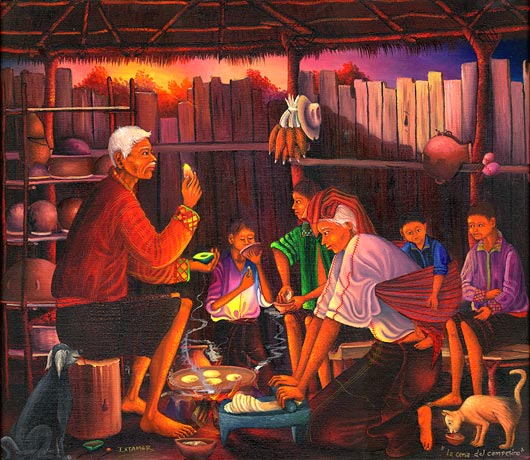

La Cena del Campesinos
(The Peasants' Dinner)
1992
19" x 23", oil on canvas.
Antonio C. Ixtamer
Bought by Vicente for Arte Maya from Ixtamer
This painting marks the beginning of Vicente Cumes Pop working with Ixtamer. Vicente Cumes Pop saw that Ixtamer had ability and desire to become a good artist, so when Ixtamer asked Vicente to help him with his art, Vicente decided to give Ixtamer four themes to see what he could do with them. Vicente came up with four highly original themes each one a larger, more complex painting than the previous. La Cena del Campesinos was the first of these four themes. Vicente decided that if Ixtamer didn’t sincerely listen and try hard to improve, he would not continue working with him after this painting, but Ixtamer was open to Vicentes ideas and criticisms. Vicente began walking from where he lived in San Pedro la Laguna to Ixtamer’s home in San Juan every couple of days to see how the painting progressed. They became good friends and they worked closely together on most of Ixtamer’s major paintings for the next four years.
Among all the people in San Pedro la Laguna and San Juan la Laguna, Ixtamer could have found no better person than Vicente to teach art. Vicente is full of ideas, he has high standards and doesn’t mince words when something doesn’t live up to his expectations. He has a good eye for quality, and is very critical of artists who copy and repeat tired themes—in other words artists who don’t spend any time thinking about their themes. He is sensitive to the unique needs and special abilities of each artist. Vicente understands the cMay 25, 2000ultural importance of the paintings and how the the art produced by the Tz’utuhil painters relates to the art of the rest of the world. Additionally Vicente could uniquely help Ixtamer financially because he had my permission to purchase any or all of Ixtamer’s paintings with money I sent him on a regular basis.
I have only seen one other painting of the theme La Cena del Campesino.
This most Mayan meal remains at the center of the traditional Mayan family’s daily life. This painting captures the essence of this daily ritual. This family is a Cachiquel family from Nahualá. Only the men of Nahualá and close-by Santa Catarina Ixtahuacan wear this style of men’s shirt with the ornate collar and cuffs, but only the men of Nahuala use the man’s wool wrap-around skirt, the men of Santa Catarina wear brown striped pants. The family has gathered around the fire and eat while the mother makes hot fresh tortillas. The women and young children sit on the ground, the father on a small stool. Black beans would be eaten with the tortillas, the tortillas used rather like a fork or spoon to scoop up the beans. In this painting we see an avocado being served, too, perhaps bought at the market as a treat, but more likely picked off a local tree. In times of little or no money this is the regular fair—tortillas and beans. When there is more money other things are included such as rice, yerbas such as chipiline, fish or crabs. Campesino families seldom eat fish or chicken, perhaps once a week. When times are really hard it is just tortillas, but tortillas and beans are the usual fare—morning, noon and night. The usual drink is a very very weak coffee sweetened with sugar and no milk. Although black beans are the staple bean dish, there are several others that are used for variety. Large red beans are cooked with a Mexican herb epazote which has a nauseating smell, but wonderful flavor; small white beans are cooked with chiles and achote which gives the broth a red color. The traditional Mayan families food is the best fare that is available in Guatemala. It is simple, pure and flavorful.
The family sitting on the floor, the mother making tortillas, the open can house, all this was part of Vicente’s original idea.. As Vicente saw how the painting was progressing, how Ixtamer was expressing his ideas, he had new ideas and improvements, among these: the light from the setting sun on the wall, the avocado, and the cat and dog. This is Ixtamer’s most original and important painting to date. To Vicente and my knowledge nobody else had painted this theme before. The style this painting, and the depiction of the people where similar to the paintings Ixtamer had been doing just before he stopped and since he resumed painting again. The next painting was to be a profound change in his style..
Exhibited:
La Peña Cultural Center, Berkeley, CA; Nov.—Dec. 1992
Café Nidal, San Francisco, CA; July 1993
French Hotel Café, Berkeley, CA; Nov. 1993
Depot Bookstore & Cafe, Mill Valley, CA.; June 1994
Krasl Art Center, St. Joseph, MI; Dec. 1994—Jan. 1995
Holland Area Arts Council, Holland Michigan; Feb. 1995
Saginaw Museum, Saginaw Michigan; May—June, 1995
Dolores Street Community Center, San Francisco, CA; Oct.10, 1995—Jan. 12, 1996
Arte Americas, Fresno, CA, May 4 to July 13, 1997
Museo Chicano, Phoenix, AZ; February & June 25—Aug 7, 1998
SOMART Gallery, San Francisco, CA; Jan. 4—22, 2000